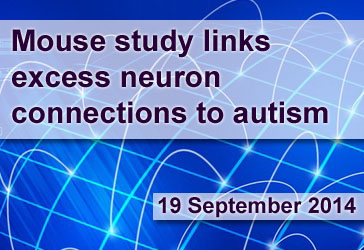Check out other stories from the Latest News
Too Many Neurons Partnered Up in Autism
By Ishita Das, PhD on September 19, 2014

Background: Soon after birth, the brain eliminates a large number of neural connections—a process called pruning. Researchers believe this fine-tuning affects connections that are weaker or in excess. Pruning proceeds alongside the earliest phases of learning. It likely helps the brain develop the sophisticated circuitry needed to respond to the environment. Researchers are investigating if pruning abnormalities underlie Autism Spectrum Disorder (ASD).
What’s new: A new study suggests that children and adolescents with ASD fail to eliminate excess neural connections after birth. New York researchers report that neurons in the brain’s temporal lobe contain more tree-like protrusions, known as spines, in adolescents with ASD compared to controls. This difference is discernable in brain samples from children with ASD as well. These spines receive input from other neurons. The temporal lobe is associated with language and speech perception, auditory and visual processing, and has been implicated in ASD etiology.
Using a mouse model, the group found that knocking out a pathway responsible for degrading parts of the cell reduced spine pruning and led to a significant increase in spine density in adolescent mice. Furthermore, using additional mouse models, the team connected spine density changes to deficiencies in social behavior and social interaction in the mice. Treatment with a drug, rapamycin, alleviated many of the social deficiencies seen in an ASD mouse model.
Why it’s important: This is the first study to show that a specific biological pathway is important for spine pruning, which this study implicates in ASD. Connecting these physical changes in the brain with behavioral features in mice is a major accomplishment in behavioral neuroscience.
Help me understand :
| Source(s) : |
| Tweet |

